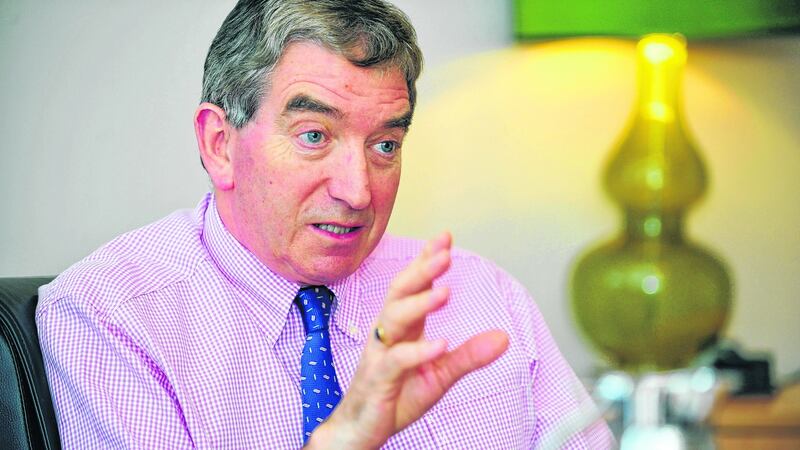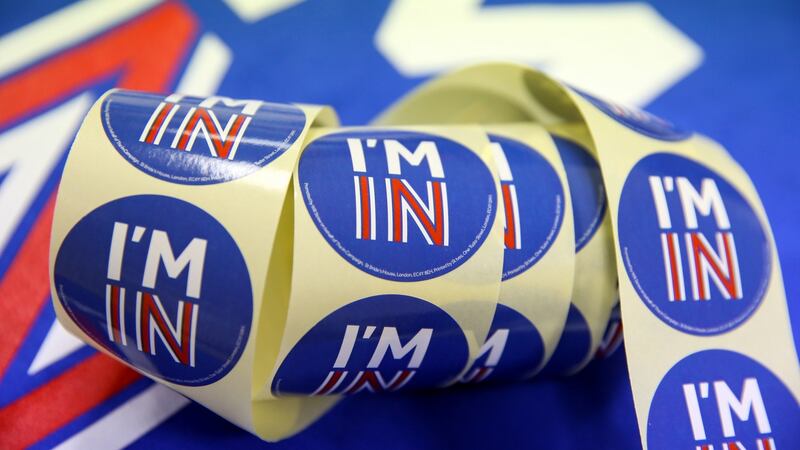On the 31st floor of the Walkie-Talkie building on Fenchurch Street, with its spectacular uninterrupted views across the City of London and along the river Thames, some of the leading Irish business figures in Britain gathered one morning this week. They were there to chew over their abiding preoccupation: Britain’s referendum on membership of the EU.
These days in London, wherever green is worn, conversations quickly turn to whether Britain will leave the EU, with anxious probing about how the campaign is going and shock at the news of unlikely supporters of Brexit.
Niall Fitzgerald, former chairman and chief executive of Unilever, set the tone at the meeting of the British Irish Chamber of Commerce, contrasting the uneasy relationship between Britain and Ireland in the 1960s with the deep cultural, political and economic ties of today.


"We owe much of our ability to build and maintain this many-faceted friendship to our common membership of the European Union, and many shared perspectives as to how the EU should evolve. Across trade, travel, infrastructure and industry, the European Union has been a key enabler of the unprecedented bilateral success, and it yields the possibility of even greater success in the years to come," he said.
“However, there is growing uncertainty over whether Britain can continue to play such a role. The forthcoming referendum on the UK’s membership of the European Union has prompted many partners, not least Ireland, to look on with concern.”
Inscrutable mask
As Fitzgerald spoke,
Peter Mandelson
sat behind him, his face an inscrutable mask as he listened closely, checking the economic figures the businessman cited against his own notes.
The former EU trade commissioner, former business secretary, former Northern Ireland secretary and fabled master of the darkest political arts, is now a businessman himself, with his own global consultancy. As a member of the House of Lords, however, he retains a foothold in politics and a perch from which he can, among other things, plot against Labour's current leader, Jeremy Corbyn.
But the referendum is Mandelson’s primary focus and he has been instrumental behind the scenes in shaping the Remain campaign (for Britain to stay in the EU), as well as emerging as one of its most pugnacious advocates.
When he stood up to speak after Fitzgerald, he predicted a hard-fought campaign with a “battle royal” for the hearts and minds of British voters.
“And remember, this is not just like any old ordinary Irish referendum,” he said. “This is literally in or out. We’re not talking about a treaty here or an amendment to a treaty or a subclause. This is it. This is the real McCoy – in or out – with no second chance.”
The Economic and Social Research Institute (ESRI) estimates that a Brexit could reduce bilateral trade flows between Ireland and the UK by 20 per cent or more and lead to a drop in average incomes in Ireland of more than 4 per cent. The direct economic impact on Northern Ireland would begin with the loss of EU development funding and agriculture funding, which will amount to £234 million (€296 million) and £173 million respectively in the five years up to 2020.
Impact on peace process
For Mandelson, the potential impact on the peace process of Brexit would be more profound than its economic cost, and he warned of the reintroduction of a “hard Border” as well as a threat to the future of the common travel area between Britain and Ireland.
“Anything in my view that strengthened a sense of separatism between Northern and Southern Ireland – physically, economically, psychologically – has the potential to upset the progress that has been made and serve as a potential source of renewed sectarianism that would always bear the risk of triggering further violence in Ireland, particularly in the North,” he said.
“In my view, that sense of separatism that would emerge from the reimposition of that Border would only serve the extremists, the sectarians, the people who don’t want people to be living together, who like the idea of separate identities and separatism keeping people apart on that island of Ireland.”
With three months to go before the referendum, the official campaign has not yet begun. On the Leave side (campaigning for Britain to exit the EU), rival groups are still competing to be recognised as the official campaign, with access to £7 million in public funding and rights to television slots.
On the face of it, the Remain side has many advantages, not least an authoritative, trusted leader in the person of prime minister David Cameron. The prime minister's renegotiation of Britain's membership terms has been widely derided as insubstantial, but he is an eloquent advocate of the broader case for Britain remaining in the EU. Most of the cabinet, almost all of the Labour Party and most of the other opposition parties, big business and the unions are all campaigning to stay in.
Cameron and his allies have focused attention on the risks involved in leaving, offering detailed warnings about the threats to economic growth, trade, jobs and security.
‘Project fear’
Leave campaigners accuse the prime minister of engaging in “project fear”, but they have yet to agree on an answer to the question of what relationship with the EU Britain should seek after Brexit.
Until London mayor Boris Johnson and justice secretary Michael Gove joined the Leave campaign, its biggest political names were Nigel Farage, George Galloway and a few low-profile cabinet ministers.
Johnson has until now disappointed expectations, appearing unprepared and uncertain of policy details in interviews and failing to counter the charge that his support for the Leave cause is rooted in political opportunism.
Gove, who was expected to add intellectual weight to the Leave campaign, has instead found himself accused of leaking to the Sun newspaper details of Queen Elizabeth's private anti-EU feelings.
Both Johnson and Gove have time to recover, however, and the Remain campaign, for all its respectability, often looks very white, male, Oxbridge-educated – and deadly dull. And despite its structural advantages, the Remain campaign has failed to open up a clear lead in the polls, many of which put the two sides neck and neck.
An ORB poll for the Daily Telegraph this week put Remain at 47 per cent and Leave at 49 per cent, effectively tied. Leave voters say they are more likely to vote, however, and when this is taken into account, the poll puts Leave on 52 per cent, with Remain on 45 per cent.
Fear is an important motivator on both sides, with one in three undecided voters saying their biggest hesitation about staying in the EU is fear of migration, and a similar proportion saying fear of job losses could put them off voting to leave.
Writing in the Daily Telegraph, Lynton Crosby, the political strategist behind Cameron's surprise election victory last May, said the poll showed that the key factor in the referendum is risk. "While much has been made of 'project fear', the reality is that voters see risk on both sides. The risk of leaving is the damage that could be caused to the UK economy. The risk of staying is the uncontrolled immigration that could result," he wrote. "This sums up the choice that voters are facing: are the economic risks of remaining in the EU bigger or smaller than the impact of uncontrolled immigration that voters believe could result?"
Uncontrolled migration
Although voters recognise the risk of economic uncertainty and uncontrolled migration, neither campaign has yet succeeded in persuading enough voters that their lives will be directly affected by either.
Crosby suggests that both sides could use public services, such as the National Health Service, to make their case, with the Remain side arguing that a strong economy is necessary to fund public services, while the Leave side claims that uncontrolled immigration will overwhelm them. Both sides agree that turnout will be the key to success in June, and the Leave campaign starts with the advantage that its core supporters, who are older, are usually more inclined to vote.
There is some evidence, too, of greater intensity of feeling on the Leave side, while most Remain supporters are confident that their side will win. Pollsters speak of a “bell curve” where turnout is concerned, with the Leave side likely to win if turnout is below about 55 per cent. Once it moves above that figure, the Remain side has the advantage, unless it moves above about 75 per cent.
“Once you get beyond that, you’re getting people who never normally vote, and they all hate the world,” one senior Conservative told me.
A close result could raise big constitutional questions, particularly if the UK votes narrowly to leave the EU but most Scots vote to stay. A poll in the Scotsman this week found that most Scots believe such an outcome should trigger a second referendum on Scottish independence and that a majority would then vote in favour.
A narrow victory for the Remain side, with England voting to leave but the Celtic nations tipping the balance in favour of staying in the EU, could also have constitutional repercussions. But right now, that is the sort of headache the Remain campaign would happily accept as the price of victory in June.










